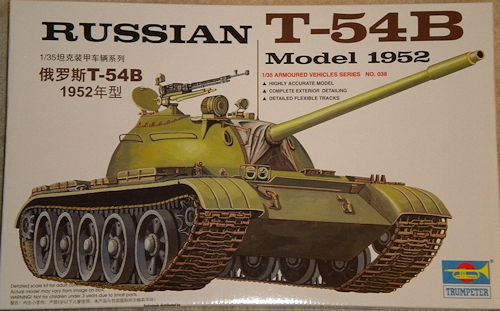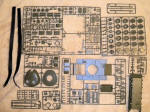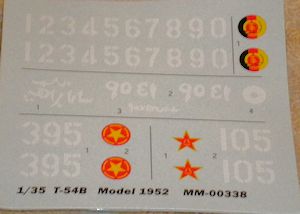
Trumpeter 1/35 T-54B Model 1952 Tank
|
KIT #: |
038 |
|
PRICE: |
$22.00 MSRP |
|
DECALS: |
Four options |
|
REVIEWER: |
|
|
NOTES: |
316 parts on 9 sprues |

The first
prototype of the T-54 was completed in 1947.
This was a logical development of the T-44 tank developed toward the end
of World War II, which was in turn a development of the infamous T-34 medium
tank. The T-54 has also been built
in China as the T-59, as well as in Czechoslovakia and Poland.
It is estimated that between 80,000 and 100,000 of all models of the T-54
and T-55 have been built.
During the
Korean War a number of US M26 and M46 tanks were captured by the Chinese, who in
turn passed on examples to the Soviet Army for evaluation.
One of the technical inovations that came from these trials was the use
of a bore evacuator on the main gun. The bore evacuator helped to reduce the
accumulation of gun fumes in the turret, which was adapted to the 100mm D-10TG
gun of the T-54. Other improvement
efforts included waterproofing and snorkling equipment, the upgraded TSH-2A-22
telescopic sight, the new TVN-1 infrared (IR) driver’s periscope and IR driving
headlight, new R-113 radio, multi-stage air cleaner, and radiator control for
better engine performance. These
improvements were accepted for production in 1955 as the T-54A.
While the T-54A
was in production, development began on improved gun stabilization systems with
an aim to increase the hit probability from 30 percent to 60 percent.
This resulted in the two-axis STP-2
Tsyklon (“Cyclone”) system, which,
following tests, was accepted for service in 1956 as the T-54B.
Other improvements that were incorporated throughout the production of
the T-54B included the new Luna L-2 searchlight, TPN-1-22-11 infrared night
sight, and OU-3 IR searchlight added to the commander’s copula.
This was the first time that the tank was fitted with full night-fighting
features. The T-54 has been used in
combat by North Vietnam, Pakistan, India, Egypt, Syria, Iraq, Angola, Algeria,
Libya and Somalia and has proven to be a reliable tank in service.
|
THE KIT |
 Upon opening
the sturdy box, you’re presented with three bags, each containing various sprues
of parts for the tank. No figures are included with the kit.
The hull bottom is not bagged.
All parts are molded in olive drab and are on the thick side.
I’ve read that, due to the thickness of the parts, it is recommended to
use glue with very strong adhesion for adhering the parts.
Though the kit contains some flash, it
is kept to a minimum. There are ejector pin marks on some parts; however,
the overall detail of the parts is quite good.
The sprues indicate that the kit was molded in 2000.
Upon opening
the sturdy box, you’re presented with three bags, each containing various sprues
of parts for the tank. No figures are included with the kit.
The hull bottom is not bagged.
All parts are molded in olive drab and are on the thick side.
I’ve read that, due to the thickness of the parts, it is recommended to
use glue with very strong adhesion for adhering the parts.
Though the kit contains some flash, it
is kept to a minimum. There are ejector pin marks on some parts; however,
the overall detail of the parts is quite good.
The sprues indicate that the kit was molded in 2000.
The kit
features the latter “starfish”-style wheels containing noticeable lines molded
on the outer part of each tire. I
initially thought that these would need to be sanded or filed off, however,
after viewing some close-up
pictures of the real deal, these lines are actually present, although they
don’t quite reach the outer
rim. The parts for the Luna L-2
searchlight and OU-3 IR searchlight specific to theT-54B are included.
Two separate gun barrels are included, one with the latter version fume
extractor molded on and the other without it representing the earlier style.
Separate roadwheel arms allow one to have the model displayed with the
wheels contoured to groundwork in a diorama setting.
The mounting hole for the characteristic T-54 turret-mounted ventilator
dome is molded in the underside of the turret and is flashed but can be easily
drilled-out from the underside. It is somewhat unclear from the instructions what the part number is for the ventilator dome as the line that normally runs from the number to the actual part is actually shown going from the number directly to the top of the turret part, however, upon closer examination it is shown that the ventilator dome part is number "J13".
The rear
exterior fuel drums common to Soviet Cold War–era tanks are included and are
well done. The kit includes the canvas gun-mantlet cover, which, although molded
in plastic, looks realistic enough.
The rough cast texture of the turret is well-represented.
There are two types of 12.7mm anti-aircrft
machine guns included, one being the DShK 1938 and the other looking somewhat
like a Type 77, with the instructions showing the commonly seen DShK 1938 as
being used for the model. The kit also
has single-length flexible rubber tracks, a small piece of nylon mesh for the
engine deck grills, nylon string for a tow rope, and a square piece of clear
acetate with some pre-cut pieces within it.
 The
instructions are of the fold-out type and are well illustrated with exploded
views showing a 16-step construction sequence.
One interesting point is that although the instructions show a diagram of
each sprue, not all of the parts on some of the sprues are shown.
There is also a section indicating which parts are not to be used, as
well as diagrams showing the exact dimensions of the cut-outs for the engine
screens and the tow rope, a nice touch.
The decals include markings for four tanks including a Syrian, Chinese,
East German, and North Vietnamese tank of the PAVN 201st armored
regiment, Dong Ha April 1972.
The
instructions are of the fold-out type and are well illustrated with exploded
views showing a 16-step construction sequence.
One interesting point is that although the instructions show a diagram of
each sprue, not all of the parts on some of the sprues are shown.
There is also a section indicating which parts are not to be used, as
well as diagrams showing the exact dimensions of the cut-outs for the engine
screens and the tow rope, a nice touch.
The decals include markings for four tanks including a Syrian, Chinese,
East German, and North Vietnamese tank of the PAVN 201st armored
regiment, Dong Ha April 1972.
|
CONCLUSIONS |
As mentioned above, this kit has been criticized by some due to difficulty
working with the thick, hard plastic.
I’ve also
read that the turret sits back a little too far and that the hull is
slightly too long. That being said,
I’ve seen this kit as a finished model and I think it represents a T-54 quite
well. Although I’m sure some
modifications to the Tamiya T-55 kit to convert it to a T-54 would produce a
great-looking model, the Trumpeter kit is a nice kit right out of the box that
is available at a very reasonable price.
I look forward to building it!
|
REFERENCES |
T-54 and T-55 Main
Battle Tanks 1944-2004 (New Vanguard)
by Steven Zaloga,
Osprey Publishing
(2004)
An Illustrated Guide to Modern Tanks and Fighting Vehicles edited by Ray Bonds, A Salamander Book by Arco Publishing, Inc. (1980)
March 2013
If you would like your product reviewed fairly and fairly quickly, please contact the editor or see other details in the Note to Contributors.